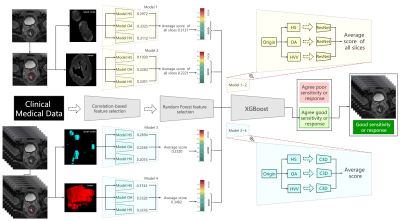1Department of Radiation Oncology, Cancer Center, West China Hospital, Sichuan University, Chengdu, China, 2Chengdu Institute of Computer Application, Chinese Academy of Sciences, Chengdu, China, 3University of Chinese Academy of Sciences, Beijing, China
We have built models for predicting sensitivity of neoadjuvant chemoradiotherapy for rectal cancer based on MRI and clinical data base AI method. The model stratified patients into different sensitivity and response groups that potentially might be used to guide selection of therapy regimes.

Table 2 Performance of models.
Abbreviations: ACC, accuracy; AUC, the mean area under the ROC curve; PPV, positive predictive value; NPV, negative predictive value (NPV); DLC, deep learning-clinical model; RC, radiomics-clinical model.

Figure 3 Flow chart and structure of deep learning-clinical model (DLC).
ROIs are processed as heterogeneity in shapes (HS), heterogeneity in voxel values (HVV) and overall appearance (OA), which represents the characteristics of ROI, shape of ROI, ROI + perROI (5-pixel-circum surrounding ROI) respectively. Six ROIs are analyzed using six ResNet9 models and C3D8 models respectively. Average of scores are ensemble score, two for ResNet9 and another two for C3D8. Outputs of the four deep learning models are combined with clinical features to predict the final result using XGBoost11.
